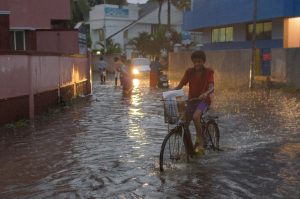70 South Asia: Physical Geography – Monsoons
A monsoon is a weather regime that creates distinct rainy and dry seasons over the course of a year. Monsoons can occur anywhere large, warm landmasses are near low-latitude oceans. The Indian subcontinent, a huge triangle of land projecting into the tropical waters of the Indian Ocean, has the most pronounced monsoon regime of any place on earth.
Monsoon Mechanics

Photo by Roehan Rengadurai on Flickr.
To understand the causes of the monsoon, it is important to understand some basic processes that influence global climates, some of which are discussed in greater detail in the introductory chapter to physical geography. First, the most direct rays of sunlight striking the earth migrate over the course of the year. From the middle of September through middle of March, the sun’s most vertical rays are in the southern hemisphere. In mid-March, the sun’s vertical rays cross the equator, bringing greater light and heat and to the northern hemisphere, including South Asia. They reach their northernmost extent in June, and places in the northern hemisphere usually receive their hottest days in July. By September, though, the sun’s vertical rays begin their migration back into the southern hemisphere, and there is less heat in the northern hemisphere.
Another basic fact that influences the monsoon is that land tends to heat up and cool down far more quickly than water. Anyone who spent time at lakeside beach in the Midwest is probably familiar with this concept. On the first warm days of late spring, the sand on the beach will be very hot just a few hours after the sun rises. It doesn’t matter that it’s been cold for six months – sand, like all of earth’s land surfaces, will heat up very fast. A few hours after the sun goes down, the sand will be relatively cool again, because land loses heat rapidly. The lake temperature is quite different. Even on a very hot day in late spring, the water can still be extremely cold. Likewise, even on a chilly day in early fall, the water will still be warm. Again, land heats up and cools down very quickly, while water heats up and cools down very slowly.
Three more fundamental facts affect the creation of the monsoon. First, as air warms up, it becomes more buoyant, and begins to rise through the atmosphere. Second, air will always flow from areas of high pressure toward areas of low pressure. Third, as air warms, its capacity to hold water vapor increases. That is, evaporation rates tend to be higher in warm weather than in cold weather. That’s why a puddle of rainwater on the sidewalk will disappear far more quickly on a hot day than on a cool day.
The Summer Monsoon
In March, as the sun’s vertical rays cross the equator, the Indian Ocean that surrounds the subcontinent experiences longer days and more intense sunlight. As the air over the ocean water warms, it begins to evaporate tremendous amounts of water vapor – the air becomes very humid. At the same time, the Indian subcontinent is also experiencing longer days and more direct sunlight. As the calendar marches toward summer, the Indian landmass becomes a sort of huge oven, cooking the air at the surface. As this air warm up, it begins to rise up through the atmosphere. The Indian Ocean is heating up as well, but at a much slower rate. Because air is rising faster over land, the air pressure there will be lower than over the sea, and humid air masses will begin to flow from the ocean toward the land. This is the beginning of a very rainy few months for the Indian subcontinent.
 Because the southern reaches of South Asia are at the lowest latitude, the land there will heat up earlier there, and therefore the monsoon flow will occur earlier there as well. By late May, the soaking rains of the summer monsoon are present in Sri Lanka and much of southern peninsular India. The monsoon rains then migrate to higher latitudes, generally from southwest to northeast. By the middle of June, the rainy season will have reached central India and Bangladesh. By July, monsoon rains will be falling throughout South Asia.
Because the southern reaches of South Asia are at the lowest latitude, the land there will heat up earlier there, and therefore the monsoon flow will occur earlier there as well. By late May, the soaking rains of the summer monsoon are present in Sri Lanka and much of southern peninsular India. The monsoon rains then migrate to higher latitudes, generally from southwest to northeast. By the middle of June, the rainy season will have reached central India and Bangladesh. By July, monsoon rains will be falling throughout South Asia.
The arrival of the summer monsoon, sometimes called the “burst,” is usually a welcome moment, since it is often preceded by many weeks of oppressive heat and humidity. It is especially welcomed by farmers, who rely on monsoon rains to grow their crops. The drawback, of course, is that the rains can be significant enough to cause severe flooding. Rainfall amounts tend to be greatest in highland areas, where they are intensified by orographic lifting. India’s Western Ghats sometimes receive as much as 200 inches of rain during the summer monsoon. India’s Khasi Hills, just north of Bangladesh, once received 35 inches of rain in one day.
The Winter Monsoon
In September, the sun’s vertical rays return to the southern hemisphere, and the summer monsoon begins its retreat from northeast to southwest. By October, the heavy rains cease in northern India and Bangladesh. By November, the summer monsoon is generally over throughout South Asia. Because the Indian landmass is no longer superheating the air over its surface, the rapid ascent of air diminishes, and air pressure begins to climb. And because the Indian Ocean will take much longer to cool, air will continue to rise from its surface, so air pressure will relatively low there. The wind changes direction, flowing from land to sea, bringing much drier conditions throughout South Asia. The dry winter monsoon lasts from November to February. In March, the conditions that form the summer monsoon begin again.
Did you know?
Hot off the Press
This article explains the travails of Pakistan, as now in September 2022, 1/3 of the country is underwater, due to extremes of the monsoon rains. https://www.nytimes.com/2022/09/03/opinion/environment/floods-in-pakistan-climate-change.html
My Turn!
CITED AND ADDITIONAL BIBLIOGRAPHY:
Rengadurai, Roehan. Monsoon. photo, 14 June 2015. Flickr, https://www.flickr.com/photos/iamroehan/18789371942/. Attribution-NonCommercial-NoDerivs 2.0 Generic (CC BY-NC-ND 2.0).

